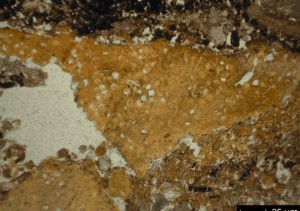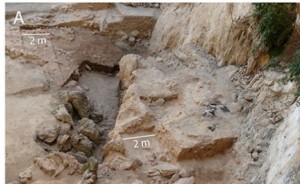Although technically considered to be “number two,” scientists have made a discovery using 50,000 year old fecal matter considered to be number one in its field. The discovery, made in a cave site at El Salt in Alicante, Spain, proves that the Neanderthals which inhabited that region did not eat only meats but they ate their veggies as well.
The Neanderthals, which are Homo Sapiens (a.k.a. modern humans) close yet extinct relatives, were our ancestors long thought to be dim-witted and solely meat-eaters. Yet, these beliefs were proven wrong when geoarchaeologist Ainara Sistiaga led a study into the caves in southern Spain and subsequently found the fossilized feces, known also as “coprolites.”
Surprisingly enough, when Sistiaga first led the investigation into the caves at El Salt, what researchers were originally looking for was chemical traces regarding what it was that Neanderthals used to cook with. “I thought they were cooking in there, so I was looking for lipids from cooking,” says Sistiaga to USA Today. As the research at the site continued, however, the poop samples were found unexpectedly on the top layer of a hearth which dates back to around 50,000 years ago. “I was quite surprised we found these samples in a place where they would eat,” says Sistiaga. “We think they were deposited after they stopped using the fire pit.”
Before these samples were recovered, many believed that the Neanderthals who lived that long ago only ate the meat of various animals which they had hunted down. Many of the previous studies relating to Neanderthal diet relied upon fossilized stomach content and the remains on food between their teeth. However, out of the samples of fecal matter recovered, two have contained cholesterol-related compounds which are consistent with that of various plants-based foods. What does this mean exactly? It means that our early human ancestors were actually well-balanced when it came to their diets.

A close-up of what scientists say is a miniature sample of Neanderthal poop. Fossilized or petrified excrement are known as “coprolites.”
In addition to revealing the presence of plant foods in Neanderthal diet, analysis of the preserved poop showed evidence of parasites, including those such as hookworms and pinworms. The numbers in which these parasites were present correspond with what scientists say would make modern humans very sick.
Overall, this new evidence has begun to shed some light on the diets of many Neanderthals long ago. As Paleontologist Erik Trinkaus of Washington University in St. Louis told National Geographic, this study of petrified excrement is the first to provide direct chemical evidence that our Neanderthal ancestors ate their vegetables along with their meat. However, it is important to remember that evidence provided by fecal residues represents only short-term information on the diets of those who left them, but as time goes on, more discoveries will undoubtedly lead to more definitive proof regarding how and what our distant relatives ate.
More Reading On This Topic Can Be Found At:
http://www.haaretz.com/archaeology/.premium-1.604951
http://www.livescience.com/46529-poop-fossils-reveal-neanderthals-ate-plants.html
Works Cited
Renfrew, Colin, and Paul G. Bahn. “Fecal Material.” Archaeology Essentials: Theories, Methods, and Practice. New York, NY: Thames & Hudson, 2010. 202-03. Print.
Sullivan, Gail. “World’s Oldest Poop Suggests Neanderthals Weren’t Meatheads.” Washington Post. The Washington Post, 26 June 2014. Web. 28 Sept. 2014.
Vergano, Dan. “What Discovery of Oldest Human Poop Reveals About Neanderthals’ Diet.” N.p., 25 June 2014. Web. 28 Sept. 2014. news.nationalgeographic.com/news/2014/06/140625-neanderthal-poop-diet-ancient-science-archaeology/
Image 1: news.nationalgeographic.com/news/2014/06/140625-neanderthal-poop-diet-ancient-science-archaeology/
Image 2: http://www.usatoday.com/story/tech/2014/06/25/human-poop-neanderthals/11105791/


The fecal matter found at the cave site at El Salt in Alicante, Spain reveals exactly how much can be gleaned from a single type of artifact at a single site. When considered within its content, the positioning of the fecal matter at the hearth reveals how and when the Neanderthals used the space. This then gives us insight into their behavior. At the same time, the chemicals and proteins found in the samples after lab analysis reveal to us more information about their diet. Simultaneously, the parasites present give us greater insight into the Neanderthal’s environment. You also mention previous studies carried out on fossilized Neanderthal stomach content. I am curious about how these former studies informed/expanded this investigation. Did this influence how the archaeologists analyzed the matter and what kinds of things they looked for? How does the fecal matter shine a new light on previous studies?
The evolution of the human diet is an important area of research since the popular Paleodiet began making claims that we evolved to eat a certain way. We are still learning about past diets and humans are still evolving. There is no one right way for humans to eat.